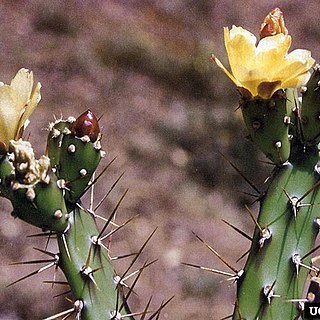Low spreading and creeping shrublets up to 1 m high, rooting where contact is made with the soil. Stems with a tuberous subterranean portion, terete above ground, much branched. Joints brittle, subterete to linear, 6-20 cm long, 1-2.5 cm broad, light green; areoles close together, woolly, with glochidia and 2-7 sharp strong radiating spines, up to 3 cm long, minutely barbed apically. Leaves rarely present. Flowers many, c. 4 cm long; hypanthium tubular, usually spineless; petaloid segments lemon yellow to golden yellow. Fruit globose, 3-4 cm in diam., red, often bearing a few spines, inedible; able to form roots and reproduce vegetatively; seeds numerous, reniform, light brown, with low viability.
Dwarf shrub, 0.3-1.0 m high; spreading, spiny; subterranean parts developed into tubers; lower (older) branch segments almost cylindric, up to 25 mm in diameter; upper segments (cladodes) somewhat compressed, not tuberculate, easily detached, bright green, sometimes tinged reddish purple. Spines usually 2 or 3 per areole, sturdy, rigid, 10-30 mm long, pale brown. Leaves 0. Flowers: 25-40 mm in diameter; perianth bright yellow; Nov.-Jan. Fruit obovoid, up to 30 mm long, purple-red or green with few spines.
Perennial, spiny, much branched, spreading, succulent shrublet, ± 1 m high; underground tubers. Cladodes cylindrical to slightly flattened, bright green, sometimes reddish purple-tinged, 60-200 mm long x 10-30 mm wide; armed with barbed spines 10-30 mm long. Leaves absent. Flowers bright yellow. Flowering time Nov.-Jan. Fruit reddish, succulent berries, sterile.
Spreading and creeping shrublets, up to 1 m high. Joints semiterete, densely spiny, 15-25 mm wide. Flowers lemon-yellow or golden yellow.
A cactus.


